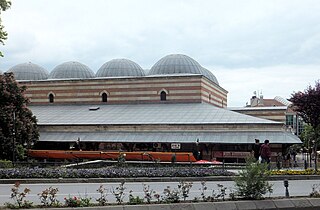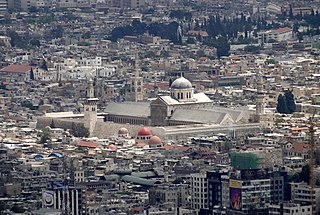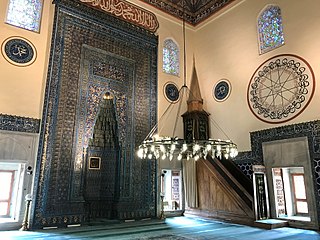
The Grand Bazaar in Istanbul is one of the largest and oldest covered markets in the world, with 61 covered streets and over 4,000 shops on a total area of 30,700 m2, attracting between 250,000 and 400,000 visitors daily. In 2014, it was listed No.1 among the world's most-visited tourist attractions with 91,250,000 annual visitors. The Grand Bazaar at Istanbul is often regarded as one of the first shopping malls of the world.

Tarsus is a municipality and district of Mersin Province, Turkey. Its area is 2,029 km2, and its population is 350,732 (2022). It is a historic city, 20 km inland from the Mediterranean Sea. It is part of the Adana-Mersin metropolitan area, the fourth-largest metropolitan area in Turkey. Tarsus forms an administrative district in the eastern part of Mersin Province and lies at the heart of the Çukurova region.

A bedesten is a type of covered market or market hall which was historically found in the cities of the Ottoman Empire. It was typically the central building of the commercial district of an Ottoman town or city, where the most important and precious goods were kept and sold. Its function was comparable or equivalent to that of a qaysariyya in other regions, though the architecture of the latter could be different and be similar to that of a bazaar with its own streets.

The Umayyad Mosque, also known as the Great Mosque of Damascus, located in the old city of Damascus, the capital of Syria, is one of the largest and oldest mosques in the world. Its religious importance stems from the eschatological reports concerning the mosque, and historic events associated with it. Christian and Muslim tradition alike consider it the burial place of John the Baptist's head, a tradition originating in the 6th century. Two shrines inside the premises commemorate the Islamic prophet Muhammad's grandson Husayn ibn Ali, whose martyrdom is frequently compared to that of John the Baptist and Jesus.

Mersin Province, formerly İçel Province, is a province and metropolitan municipality in southern Turkey, on the Mediterranean coast between Antalya and Adana. Its area is 16,010 km2, and its population is 1,916,432 (2022). The provincial capital and the biggest city in the province is Mersin, which is composed of four municipalities and district governorates: Akdeniz, Mezitli, Toroslar and Yenişehir. Next largest is Tarsus, the birthplace of Paul the Apostle. The province is considered to be a part of the geographical, economical and cultural region of Çukurova, which covers the provinces of Mersin, Adana, Osmaniye and Hatay.

Uzunköprü is a town in Edirne Province in Turkey. It is named after a historical stone bridge, claimed to be the world's longest, on the Ergene River. It is a strategically important border town, located on the routes connecting Turkey to the Balkans and Europe. It is the seat of Uzunköprü District. Its population is 39,577 (2022). Uzunköprü is the third most populous town of Edirne Province.

The Great Mosque of Gaza, also known as the Great Omari Mosque, was the largest and oldest mosque in all of Gaza, Palestine, located in Gaza City.

Saint Paul's Church is a former church in Tarsus, Mersin Province, Turkey.

Altından geçme is a gate in the city wall of Tarsus, Mersin Province, Turkey, originally part of a Roman bath.

Kırkkaşık Bedesten is a bedesten in Tarsus, Turkey. There are figures of lotus carved on the pediment of the bedesten. In the Medieval Age, the people named the bedesten Kırkkaşık because they mistook the lotuses for spoons.

Abbasid architecture developed in the Abbasid Caliphate, primarily in its heartland of Mesopotamia (Iraq). The great changes of the Abbasid era can be characterized as at the same time political, geo-political and cultural. The Abbasid period starts with the destruction of the Umayyad ruling family and its replacement by the Abbasids, and the position of power is shifted to the Mesopotamian area. As a result there was a corresponding displacement of the influence of classical and Byzantine artistic and cultural standards in favor of local Mesopotamian models as well as Persian. The Abbasids evolved distinctive styles of their own, particularly in decoration. This occurred mainly during the period corresponding with their power and prosperity between 750 and 932.

Tarsus Museum is an archaeology and ethnography museum in Tarsus, Mersin Province, in southern Turkey.

The Ioannina Castle is the fortified old town of the city of Ioannina in northwestern Greece. The present fortification dates largely to the reconstruction under Ali Pasha in the late Ottoman period, but incorporates also pre-existing Byzantine elements.

Bedesten or Bedestan is a historical building in the Selimiye quarter of North Nicosia, North Cyprus, located directly beside the Selimiye Mosque. The structure has a long and complicated history spanning more than one thousand years. Originally built as a church in about the sixth century, and expanded and rebuilt between the twelfth and sixteenth centuries, dedicated to Saint Nicholas, it was converted to a bedesten, a type of covered market, during the period of Ottoman rule. It is currently used as a cultural centre.

Tarsus Old Mosque is a mosque converted from a historic church located in Tarsus ilçe of Mersin Province, southern Turkey.

The Mousoleum of Danyal is a small complex in Tarsus, Turkey, consisting of a mosque and a tomb, which is believed to be that of the biblical figure Daniel. Two arches of a Roman bridge were found in the basement of the mosque-tomb complex during a renovation project.

Kubat Pasha Madrasa is a historic madrasa building in Tarsus district of Mersin Province, southern Turkey.

Bilal-i Habeşi Masjid is a historical small mosque in Tarsus, Mersin Province, Turkey.

Early Ottoman architecture corresponds to the period of Ottoman architecture roughly up to the 15th century. This article covers the history of Ottoman architecture up to the end of Bayezid II's reign, prior to the advent of what is generally considered "classical" Ottoman architecture in the 16th century. Early Ottoman architecture was a continuation of earlier Seljuk and Beylik architecture while also incorporating local Byzantine influences. The new styles took shape in the capital cities of Bursa and Edirne as well as in other important early Ottoman cities such as Iznik. Three main types of structures predominated in this early period: single-domed mosques, "T-plan" buildings, and multi-domed buildings. Religious buildings were often part of larger charitable complexes (külliyes) that included other structures such as madrasas, hammams, tombs, and commercial establishments.

The architecture of Tunisia began with the ancient civilizations such as the Carthaginians, Numidians, and Romans. After the 7th century, Islamic architecture developed in the region under a succession of dynasties and empires. In the late 19th century French colonial rule introduced European architecture, and modern architecture became common in the second half of the 20th century. The southern regions of the country are also home to diverse examples of local vernacular architecture used by the Berber (Amazigh) population.






















